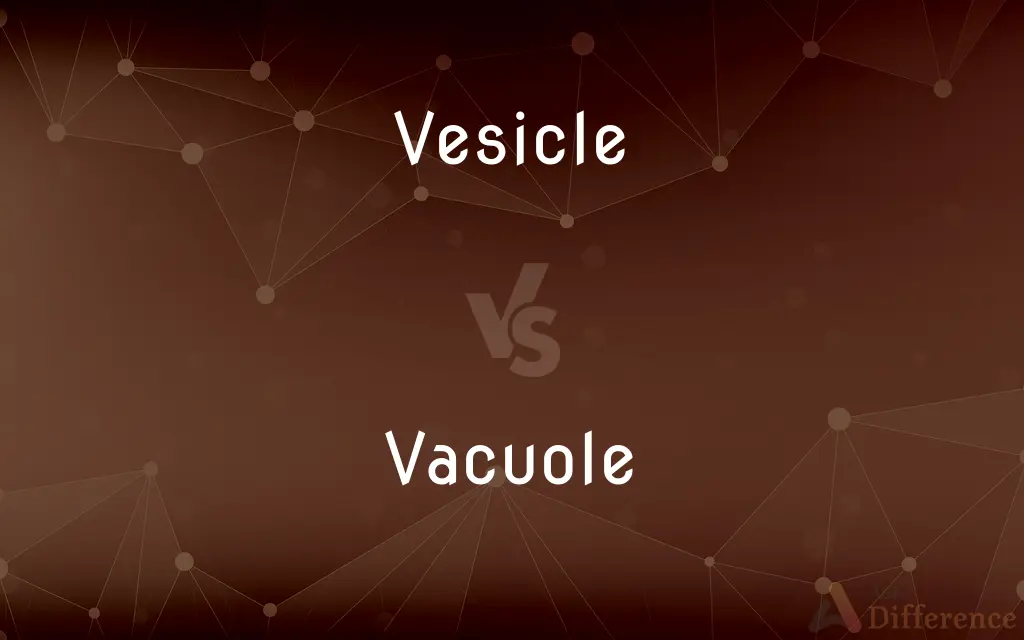Vesicle vs. Vacuole — What's the Difference?
By Fiza Rafique & Urooj Arif — Updated on March 13, 2024
Vesicles are small, membrane-bound sacs within cells, involved in transport and storage, whereas vacuoles, usually larger, are primarily found in plant cells, aiding in storage, waste disposal, and growth.

Difference Between Vesicle and Vacuole
Table of Contents
ADVERTISEMENT
Key Differences
Vesicles are tiny membrane-bound sacs that transport substances within a cell. They play key roles in metabolism, enzyme storage, and the transport of molecules. On the other hand, vacuoles are larger cellular structures, predominantly found in plant and fungal cells, and are involved in storing nutrients, waste products, and in maintaining turgor pressure within the cell.
Vesicles are formed from the endoplasmic reticulum or Golgi apparatus and are crucial for transporting proteins and lipids between cell organelles and to the cell surface. Whereas vacuoles are often formed by the fusion of multiple vesicles and are used for the storage of a wide variety of substances, including water, enzymes, and salts.
Vesicles participate actively in cellular processes such as exocytosis and endocytosis, facilitating the movement of molecules in and out of the cell. Vacuoles, however, are more passive, providing structural support and storing substances that the cell might use in the future or need to segregate from the cytoplasm.
In animal cells, vesicles are involved in processes like neurotransmitter release at synapses, indicating their critical role in communication between neurons. In contrast, vacuoles in plant cells are involved in processes such as growth and maintaining the cell's shape by absorbing water and expanding.
The diversity of vesicles, including lysosomes, peroxisomes, and secretory vesicles, highlights their specialized functions in cellular activities. Meanwhile, the vacuole's primary role revolves around the maintenance of osmotic balance and the storage of important biological molecules.
ADVERTISEMENT
Comparison Chart
Size
Generally small
Usually large
Presence
In both animal and plant cells
Primarily in plant and fungal cells
Function
Transport, storage of proteins and lipids
Storage of water, waste disposal, maintaining pressure
Formation
From the ER or Golgi apparatus
By the fusion of multiple vesicles
Role in cell
Critical for exocytosis and endocytosis
Provides structural support, stores nutrients
Compare with Definitions
Vesicle
Small, membrane-bound sacs.
Vesicles transport proteins from the Golgi apparatus to their destination.
Vacuole
Large storage organelles in cells.
Vacuoles in plant cells store water and maintain turgor pressure.
Vesicle
Forms from the ER or Golgi.
After protein synthesis, vesicles bud off the ER.
Vacuole
Maintains osmotic balance.
Vacuoles absorb water to help the cell expand.
Vesicle
Involved in cellular transport.
Vesicles carry neurotransmitters to the synaptic cleft.
Vacuole
Stores nutrients and waste products.
Vacuoles can contain waste products to be expelled or reused.
Vesicle
Variety includes lysosomes, peroxisomes.
Lysosomes are vesicles that contain digestive enzymes.
Vacuole
Formed by the fusion of vesicles.
Several small vesicles can merge to form a large vacuole.
Vesicle
Participates in exocytosis and endocytosis.
Vesicles fuse with the cell membrane to release their content.
Vacuole
Primarily found in plant and fungal cells.
A central vacuole occupies most of the plant cell's interior.
Vesicle
(Cytology) A membrane-bound structure within a cell in which materials such as enzymes are transported or stored.
Vacuole
A vacuole () is a membrane-bound organelle which is present in plant and fungal cells and some protist, animal, and bacterial cells. Vacuoles are essentially enclosed compartments which are filled with water containing inorganic and organic molecules including enzymes in solution, though in certain cases they may contain solids which have been engulfed.
Vesicle
(Anatomy) A sac or cyst, especially one containing fluid.
Vacuole
A membrane-bound organelle in the cytoplasm of most cells, especially plant cells, containing water and dissolved substances such as salts, sugars, enzymes, and amino acids.
Vesicle
(Medicine) A blister of the skin.
Vacuole
A small extracellular cavity or space within tissues.
Vesicle
(Geology) A cavity formed in volcanic rock by entrapment of a gas bubble during solidification.
Vacuole
(cytology) A large membrane-bound vesicle in a cell's cytoplasm.
Vesicle
(cytology) A membrane-bound compartment found in a cell.
Vacuole
A small empty or air-filled space or vacuity.
Vesicle
A small bladder-like cell or cavity, as:
Vacuole
A small air cell, or globular space, in the interior of organic cells, either containing air, or a pellucid watery liquid, or some special chemical secretions of the cell protoplasm.
Vesicle
(botany) A small sac filled with juice, one of many constituting the pulp of a fruit such as an orange, lemon, or grapefruit.
Vacuole
A tiny cavity filled with fluid in the cytoplasm of a cell
Vesicle
A small sac or cyst or vacuole, especially one containing fluid. A blister formed in or beneath the skin, containing serum. A bleb.
Vesicle
(anatomy) A pocket of embryonic tissue that is the beginning of an organ.
Vesicle
(geology) A small cavity formed in volcanic rock by entrapment of a gas bubble during solidification.
Vesicle
A bladderlike vessel; a membranous cavity; a cyst; a cell.
Vesicle
A small bladderlike body in the substance of a vegetable, or upon the surface of a leaf.
Vesicle
A small, and more or less circular, elevation of the cuticle, containing a clear watery fluid.
Vesicle
A cavity or sac, especially one filled with fluid; as, the umbilical vesicle.
Vesicle
A small convex hollow prominence on the surface of a shell or a coral.
Vesicle
A small cavity, nearly spherical in form, and usually of the size of a pea or smaller, such as are common in some volcanic rocks. They are produced by the liberation of watery vapor in the molten mass.
Vesicle
A small anatomically normal sac or bladderlike structure (especially one containing fluid)
Common Curiosities
Can vacuoles be found in animal cells?
Yes, but they are smaller and less common compared to those in plant and fungal cells.
Can vesicles fuse with other cell organelles?
Yes, vesicles can fuse with the plasma membrane or other organelles to deliver their contents.
What is a vesicle?
A vesicle is a small, membrane-bound sac within cells that transports and stores molecules.
What is a vacuole?
A vacuole is a large storage sac found mainly in plant and fungal cells, important for storing nutrients and maintaining cellular pressure.
What substances do vesicles transport?
Vesicles transport proteins, lipids, and other molecules within the cell and to the cell surface.
How do vesicles contribute to the immune response?
Vesicles like lysosomes contain enzymes that can break down foreign particles and pathogens.
How do vesicles form?
Vesicles form from the endoplasmic reticulum or Golgi apparatus through a process called budding.
How do vesicles and vacuoles differ in size?
Vesicles are generally small, while vacuoles are larger and can occupy a significant portion of the cell.
Why are vacuoles important in plant cells?
Vacuoles store water and other nutrients, help dispose of waste, and maintain cell pressure and growth.
What is the role of vacuoles in osmotic balance?
Vacuoles help maintain osmotic balance by storing or expelling water to adjust the cell's internal pressure.
What types of molecules can vacuoles store?
Vacuoles can store a wide variety of molecules, including enzymes, salts, and organic acids.
Are vesicles involved in cell communication?
Yes, vesicles play a crucial role in cell communication, particularly in the release of neurotransmitters in neurons.
What is the difference between a vesicle and a lysosome?
A lysosome is a type of vesicle that contains digestive enzymes, specifically involved in breaking down cellular waste.
Do all plant cells have vacuoles?
Most plant cells contain a large central vacuole, which is crucial for their structure and function.
Can vacuoles change size?
Yes, vacuoles can change size, especially in plant cells, as they store or release water.
Share Your Discovery

Previous Comparison
Bitterness vs. Resentment
Next Comparison
Internet vs. IntranetAuthor Spotlight
Written by
Fiza RafiqueFiza Rafique is a skilled content writer at AskDifference.com, where she meticulously refines and enhances written pieces. Drawing from her vast editorial expertise, Fiza ensures clarity, accuracy, and precision in every article. Passionate about language, she continually seeks to elevate the quality of content for readers worldwide.
Co-written by
Urooj ArifUrooj is a skilled content writer at Ask Difference, known for her exceptional ability to simplify complex topics into engaging and informative content. With a passion for research and a flair for clear, concise writing, she consistently delivers articles that resonate with our diverse audience.














































